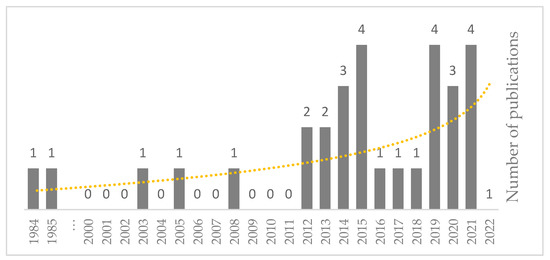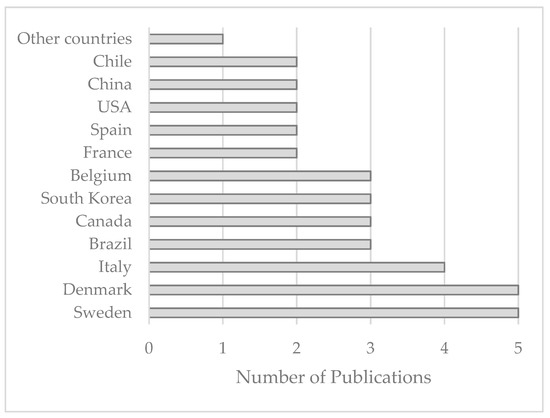
| Version | Summary | Created by | Modification | Content Size | Created at | Operation |
|---|---|---|---|---|---|---|
| 1 | Zahir Barahmand | -- | 3354 | 2023-01-05 10:41:08 | | | |
| 2 | Jason Zhu | Meta information modification | 3354 | 2023-01-06 03:54:11 | | |
Video Upload Options
A growing awareness of global climate change has led to an increased interest in investigating renewable energy sources, such as the anaerobic digestion of biomass. This process utilizes a wide range of microbial communities to degrade biodegradable material in feedstock through a complex series of biochemical interactions. Anaerobic digestion exhibits nonlinear dynamics due to the complex and interacting biochemical processes involved. Due to its dynamic and nonlinear behavior, uncertain feedstock quality, and sensitivity to the process’s environmental conditions, anaerobic digestion is highly susceptible to instabilities. Therefore, in order to model and operate a biogas production unit effectively, it is necessary to understand which parameters are most influential on the model outputs.
1. Introduction
2. Classification Based on the Publication Year

3. Classification Based on the Publication Country

4. Classification Based on Document Type
5. Local Approaches
5.1. Local Sensitivity Analysis
5.2. Parametric Sensitivity Analysis
5.3. Local Relative Sensitivity Analysis
5.4. Dynamic Sensitivity Analysis
6. Global Approaches
References
- Boutoute, A.; Di Miceli Raimondi, N.; Guilet, R.; Cabassud, M.; Amodeo, C.; Benbelkacem, H.; Buffiere, P.; Teixeira Franco, R.; Hattou, S. Development of a Sensitivity Analysis Method to Highlight Key Parameters of a Dry Anaerobic Digestion Reactor Model. Biochem. Eng. J. 2021, 173, 108085.
- Kil, H.; Xi, Y.; Li, D. A New Waste Characterization Method for the Anaerobic Digestion Based on ADM1. Chem. Eng. Commun. 2017, 204, 1428–1444.
- Taherdanak, M.; Zilouei, H. Biogas Production From Agricultural Residues: A Review. Curr. Biochem. Eng. (Discontin.) 2016, 3, 188–199.
- Emebu, S.; Pecha, J.; Janáčová, D. Review on Anaerobic Digestion Models: Model Classification & Elaboration of Process Phenomena. Renew. Sustain. Energy Rev. 2022, 160, 112288.
- Eastman, J.A.; Ferguson, J.F. Solubilization of Particulate Organic Carbon during the Acid Phase of Anaerobic Digestion. J. Water Pollut. Control Fed. 1981, 53, 352–366.
- Trucchia, A.; Frunzo, L. Surrogate Based Global Sensitivity Analysis of ADM1-Based Anaerobic Digestion Model. J. Environ. Manag. 2021, 282, 111456.
- Panaro, D.B.; Frunzo, L.; Mattei, M.R.; Luongo, V.; Esposito, G. Calibration, Validation and Sensitivity Analysis of a Surface-Based ADM1 Model. Ecol. Model. 2021, 460, 109726.
- Batstone, D.J.; Keller, J.; Angelidaki, I.; Kalyuzhnyi, S.V.; Pavlostathis, S.G.; Rozzi, A.; Sanders, W.T.M.; Siegrist, H.; Vavilin, V.A. The IWA Anaerobic Digestion Model No 1 (ADM1). Water Sci. Technol. 2002, 45, 65–73.
- Sadrimajd, P.; Mannion, P.; Howley, E.; Lens, P.N.L. PyADM1: A Python Implementation of Anaerobic Digestion Model No. 1; bioRexiv: New York, NY, USA, 2021.
- Parker, W. Application of the ADM1 Model to Advanced Anaerobic Digestion. Bioresour. Technol. 2005, 96, 1832–1842.
- Ramírez, I. ADM1 Applications for a Hybrid Up-Flow Anaerobic Sludge-Filter Bed Reactor Performance and for a Batch Thermophilic Anaerobic Digestion of Thermally Pretreated Waste Activated Sludge. Rev. Fac. De Ing. Univ. De Antioq. 2012, 65, 167–179.
- Barahmand, Z. Comprehensive Local Sensitivity Analysis of the ADM1-Based Anaerobic Digestion Process; WIT Press: Southampton, UK, 2022; pp. 235–246.
- Tassew, F.A.; Bergland, W.H.; Dinamarca, C.; Bakke, R. Influences of Temperature and Substrate Particle Content on Granular Sludge Bed Anaerobic Digestion. Appl. Sci. 2019, 10, 136.
- Fezzani, B.; Cheikh, R.B. Implementation of IWA Anaerobic Digestion Model No. 1 (ADM1) for Simulating the Thermophilic Anaerobic Co-Digestion of Olive Mill Wastewater with Olive Mill Solid Waste in a Semi-Continuous Tubular Digester. Chem. Eng. J. 2008, 141, 75–88.
- Jeppsson, U.; Rosen, C. Aspects on ADM1 Implementation within the BSM2 Framework; Department of the Industrial Electrical Engineering and Automation, Lund Institute of Technology: Lund, Sweden, 2006.
- Henze, M.; Gujer, W.; Mino, T.; van Loosedrecht, M. Activated Sludge Models ASM1, ASM2, ASM2d and ASM3; IWA Publishing: London, UK, 2006.
- Rajendran, K.; Kankanala, H.R.; Lundin, M.; Taherzadeh, M.J. A Novel Process Simulation Model (PSM) for Anaerobic Digestion Using Aspen Plus. Bioresour. Technol. 2014, 168, 7–13.
- Ramin, E.; Flores, X.; Sin, G.; Gernaey, K.V.; Jeppsson, U.; Steen Mikkelsen, P.; Plósz, B.G. Relative Importance of Secondary Settling Tank Models in WWTP Simulations—A Global Sensitivity Analysis Using BSM2. In Proceedings of the Sixth Biannial Meeting of the International Environmental Modelling and Software Society, Leipzig, Germany, 1–5 July 2012; pp. 588–595.
- Benedetti, L.; Batstone, D.J.; De Baets, B.; Nopens, I.; Vanrolleghem, P.A. Global Sensitivity Analysis of Biochemical, Design and Operational Parameters of the Benchmark Simulation Model No. 2; International Environmental Modelling and Software Society: Viganello, Switzerland, 2008; Volume 2, pp. 1322–1330.
- Vavilin, V.A.; Rytov, S.V.; Pavlostathis, S.G.; Jokela, J.; Rintala, J. A Distributed Model of Solid Waste Anaerobic Digestion: Sensitivity Analysis. Water Sci. Technol. 2003, 48, 147–154.
- Iancu, E.; Petre, E. Control Strategy Based on Sensitivity Analysis. Application for Anaerobic Digestion Bioprocess. In Proceedings of the 2017 21st International Conference on Control Systems and Computer Science (CSCS), Bucharest, Romania, 29–31 May 2016; pp. 84–89.
- Xu, Z. ADM1 Parameter Calibration Method Based on Partial Least Squares Regression Framework for Industrial-Scale Anaerobic Digestion Modelling. Master’s Thesis, Stellenbosch University, Stellenbosch, South Africa, 2019.
- Li, D.; Lee, I.; Kim, H. Application of the Linearized ADM1 (LADM) to Lab-Scale Anaerobic Digestion System. J. Environ. Chem. Eng. 2021, 9, 105193.
- Silva, M.I.; De Bortoli, A.L. Sensitivity Analysis for Verification of an Anaerobic Digestion Model. Int. J. Appl. Comput. Math 2020, 6, 38.
- Voss, D.A. Fourth-Order Parallel Rosenbrock Formulae for Stiff Systems. Math. Comput. Model. 2004, 40, 1193–1198.
- Fatolahi, Z.; Arab, G.; Razaviarani, V. Calibration of the Anaerobic Digestion Model No. 1 for Anaerobic Digestion of Organic Fraction of Municipal Solid Waste under Mesophilic Condition. Biomass Bioenergy 2020, 139, 105661.
- Shannon, C.E. A Mathematical Theory of Communication. Bell Syst. Tech. J. 1948, 27, 379–423.
- Fuess, L.T.; Zaiat, M. Economics of Anaerobic Digestion for Processing Sugarcane Vinasse: Applying Sensitivity Analysis to Increase Process Profitability in Diversified Biogas Applications. Process Saf. Environ. Prot. 2018, 115, 27–37.
- McLeod, J.D.; Othman, M.Z.; Beale, D.J.; Joshi, D. The Use of Laboratory Scale Reactors to Predict Sensitivity to Changes in Operating Conditions for Full-Scale Anaerobic Digestion Treating Municipal Sewage Sludge. Bioresour. Technol. 2015, 189, 384–390.
- Nordstokke, D.; Colp, S.M. Factorial Design. In Encyclopedia of Quality of Life and Well-Being Research; Michalos, A.C., Ed.; Springer: Dordrecht, The Netherlands, 2014; pp. 2144–2145. ISBN 978-94-007-0753-5.
- Benbelkacem, H.; Bollon, J.; Gourdon, R.; Buffière, P. Dry Anaerobic Digestion Modelling: Parameter Sensitivity. Can. J. Chem. Eng. 2015, 93, 386–390.
- Atallah, N.M.; El-Fadel, M.; Ghanimeh, S.; Saikaly, P.; Abou-Najm, M. Performance Optimization and Validation of ADM1 Simulations under Anaerobic Thermophilic Conditions. Bioresour. Technol. 2014, 174, 243–255.
- Souza, T.S.O.; Carvajal, A.; Donoso-Bravo, A.; Peña, M.; Fdz-Polanco, F. ADM1 Calibration Using BMP Tests for Modeling the Effect of Autohydrolysis Pretreatment on the Performance of Continuous Sludge Digesters. Water Res. 2013, 47, 3244–3254.
- Jeong, H.-S.; Suh, C.-W.; Lim, J.-L.; Lee, S.-H.; Shin, H.-S. Analysis and Application of ADM1 for Anaerobic Methane Production. Bioprocess Biosyst. Eng. 2005, 27, 81–89.
- Schiochet Pinto, L.; Pinheiro Neto, D.; de Leles Ferreira Filho, A.; Domingues, E.G. An Alternative Methodology for Analyzing the Risk and Sensitivity of the Economic Viability for Generating Electrical Energy with Biogas from the Anaerobic Bio-Digestion of Vinasse. Renew. Energy 2020, 155, 1401–1410.
- Tian, W. A Review of Sensitivity Analysis Methods in Building Energy Analysis. Renew. Sustain. Energy Rev. 2013, 20, 411–419.
- Hamby, D.M. A Review of Techniques for Parameter Sensitivity Analysis of Environmental Models. Environ. Monit Assess 1994, 32, 135–154.
- Saltelli, A. Sensitivity Analysis: Could Better Methods Be Used? J. Geophys. Res. Atmos. 1999, 104, 3789–3793.
- Chen, X.; Chen, Z.; Wang, X.; Huo, C.; Hu, Z.; Xiao, B.; Hu, M. Application of ADM1 for Modeling of Biogas Production from Anaerobic Digestion of Hydrilla Verticillata. Bioresour. Technol. 2016, 211, 101–107.
- Havlik, I.; Votruba, J.; Sobotka, M.; Volesky, B. Parametric Sensitivity in Modeling of Anaerobic Digestion. Biotechnol. Lett. 1984, 6, 607–610.
- Barrera, E.L.; Spanjers, H.; Solon, K.; Amerlinck, Y.; Nopens, I.; Dewulf, J. Modeling the Anaerobic Digestion of Cane-Molasses Vinasse: Extension of the Anaerobic Digestion Model No. 1 (ADM1) with Sulfate Reduction for a Very High Strength and Sulfate Rich Wastewater. Water Res. 2015, 71, 42–54.
- Dereli, R.K.; Ersahin, M.E.; Ozgun, H.; Ozturk, I.; Aydin, A.F. Applicability of Anaerobic Digestion Model No. 1 (ADM1) for a Specific Industrial Wastewater: Opium Alkaloid Effluents. Chem. Eng. J. 2010, 165, 89–94.
- Lee, M.-Y.; Suh, C.-W.; Ahn, Y.-T.; Shin, H.-S. Variation of ADM1 by Using Temperature-Phased Anaerobic Digestion (TPAD) Operation. Bioresour. Technol. 2009, 100, 2816–2822.
- Fortela, D.L.B.; Sharp, W.W.; Revellame, E.D.; Hernandez, R.; Gang, D.; Zappi, M.E. Computational Evaluation for Effects of Feedstock Variations on the Sensitivities of Biochemical Mechanism Parameters in Anaerobic Digestion Kinetic Models. Biochem. Eng. J. 2019, 143, 212–223.
- Pastor-Poquet, V.; Papirio, S.; Harmand, J.; Steyer, J.-P.; Trably, E.; Escudié, R.; Esposito, G. Assessing Practical Identifiability during Calibration and Cross-Validation of a Structured Model for High-Solids Anaerobic Digestion. Water Res. 2019, 164, 114932.
- Al, R.; Behera, C.R.; Zubov, A.; Gernaey, K.V.; Sin, G. Meta-Modeling Based Efficient Global Sensitivity Analysis for Wastewater Treatment Plants—An Application to the BSM2 Model. Comput. Chem. Eng. 2019, 127, 233–246.
- Crestaux, T.; Le Maitre, O.; Martinez, J.-M. Polynomial Chaos Expansion for Sensitivity Analysis. Reliab. Eng. Syst. Saf. 2009, 94, 1161–1172.
- Minh, L.Q.; Duong, P.L.T.; Lee, M. Global Sensitivity Analysis and Uncertainty Quantification of Crude Distillation Unit Using Surrogate Model Based on Gaussian Process Regression. Ind. Eng. Chem. Res. 2018, 57, 5035–5044.
- Cao, M.; Alkayem, N.F.; Pan, L.; Novák, D. Advanced Methods in Neural Networks-Based Sensitivity Analysis with Their Applications in Civil Engineering; IntechOpen: London, UK, 2016; ISBN 978-953-51-2705-5.
- Fathaddin, M.T.; Arshanda, M.I.; Rachman, Y.A.; Putra, E.A.P.; Nugrahanti, A.; Kasmungin, S. Sensitivity Analysis in Using of Artificial Neural Network Models to Determine Infill Well Locations in a Mature Oil Field. IOP Conf. Ser. Earth Environ. Sci. 2018, 212, 012070.
- Solon, K.; Flores-Alsina, X.; Gernaey, K.; Jeppsson, U. Effects of Influent Fractionation, Kinetics, Stoichiometry and Mass Transfer on CH4, H2 and CO2 Production for (Plant-Wide) Modeling of Anaerobic Digesters. Water Sci. Technol. 2015, 71, 870–877.
- Ramin, E.; Flores-Alsina, X.; Sin, G.; Gernaey, K.; Jeppsson, U.; Mikkelsen, P.; Plósz, B. Influence of Selecting Secondary Settling Tank Sub-Models on the Calibration of WWTP Models—A Global Sensitivity Analysis Using BSM2. Chem. Eng. J. 2014, 241, 28–34.




